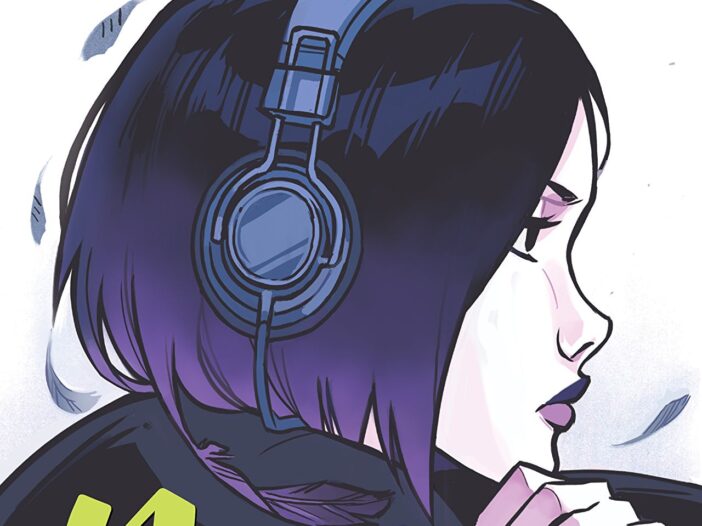
Review: ‘Teen Titans: Raven’

Teen Titans: Raven
Writer: Kami Garcia
Artist: Gabriel Picolo
DC Comics; $16.99
Beautiful Creatures co-writer Kami Garcia had a particularly challenging subject for her DC Ink original graphic novel, Teen Titans: Raven. The two previous characters to star in books from DC’s new imprint, for which they’ve enlisted successful YA prose authors to reinvent various superheroes as teenage YA protagonists, were Mera and Catwoman. The former was a relatively minor supporting character whose youth had never really been explored before, and the latter, while one of DC’s most prominent female characters in all media, rarely starred in stories focused on her teenage years.
Raven, on the other hand, has always been a teenager in all of her incarnations, dating back to her 1980 creation, which means Garcia didn’t have the open space to fill in that Danielle Paige and Lauren Myracle had with Mera and Catwoman, respectively. Her story was inevitably going to be more directly competing with all past Raven characterizations in comics, cartoons, and most recently, live-action television.
ADVERTISEMENT
ADVERTISEMENT
That she succeeds so well likely has a lot to do with the fact that while she doesn’t quite strip away all of the superhero elements of Raven, she at least reduces them to the barest core necessities. There are no superhero costumes, just fashion. There are no superhero code names, just a nickname, and no secret identities, although there are plenty of secrets. There are no superpowers, but there are magical powers, and, thus far at least, Raven seems to be more or less one-of-a-kind, rather than part of a sprawling superhero universe.
What Garcia kept was the fact that Raven is the half-demon daughter of red-skinned, six-eyed, antlered Trigon and a human woman, that she has empathic powers among her mysterious magical abilities, and that she feels torn between the good and evil paths her parents represent. And that’s about it. Other than that, her Rachel “Raven” Roth feels brand new.
Garcia’s Raven, created with artist Gabriel Picolo, has just learned of her own otherworldly origins in the first pages of the book, when a terrible car accident kills her foster mother and plunges her into amnesia. She moves to New Orleans, where she’s taken in by her late mother’s estranged sister, and gets a sister of her own in the form of Max.
In addition to the expected difficulties of adjusting to a new city, new school, and new peer group and struggling with a complete loss of memory, Raven’s pretty sure she’s going crazy, as she can hear her fellow students’ thoughts, feel their feelings, and occasionally, hear a dark voice suggesting bad things to her…bad things that she seems to be able to make happen by merely thinking about them.
There may be something tired and soap operatic about the amnesia plot, but it quite effectively allows Garcia and Picolo to structure a graphic novel around Raven discovering her origins and powers and therefore introduce readers to them in a gradual, satisfyingly paced narrative, as we are learning about them at the same time she is.
ADVERTISEMENT
ADVERTISEMENT
Similarly, some might take offense at the voodoo trappings that Garcia grounds the magical elements of the story in, but they too serve a dramatic purpose, providing a cultural framework for what, in previous comics, would simply have been treated as superpowers (DC’s last attempt to court a YA audience to the Teen Titans characters with an original graphic novel series was the 2014-2016 Teen Titans: Earth One, which grounded Raven’s powers in Native American spirituality).
As with the two previous DC Ink books, Teen Titans: Raven has more of a bookstore graphic novel aesthetic than a comic shop floppy look, Picolo’s artwork appearing in black and white with gray washes and spot colors. Raven’s black hair has always-visible purple highlights, her powers are highlighted in purple, and characters will occasionally appear rendered in full color, particularly when first being introduced or having some sort of breakthrough moment (Trigon, who appears at the climax, is always in color, highlighting his otherworldliness).
There’s an unresolved subplot involving a big guy with a white beard and eye patch named Slade who is skulking around the background of the story and apparently targeting kids with special abilities, a subplot that leads to perhaps the least realistic moment of the book: Teenage Raven leaving her new family to look for him because it’s just something “she has to do alone.” That too can probably be forgiven though, as this isn’t Garcia and Picolo’s only planned Teen Titans graphic novel; the book contains a 12-page preview of their Teen Titans: Beast Boy, scheduled for release next summer.
That seems to be another thing that separates Raven from the Mera and Catwoman books. It may be a standalone book, but it’s ending is an open one, and there is at least one thread that we know will continue into another book…although I wouldn’t be surprised if it was more like four to six other books, depending on how big this version of the Teen Titans gets.
Filed under: Graphic Novels, Reviews, Young Adult
About J. Caleb Mozzocco
J. Caleb Mozzocco is a way-too-busy freelance writer who has written about comics for online and print venues for a rather long time now. He currently contributes to Comic Book Resources' Robot 6 blog and ComicsAlliance, and maintains his own daily-ish blog at EveryDayIsLikeWednesday.blogspot.com. He lives in northeast Ohio, where he works as a circulation clerk at a public library by day.
ADVERTISEMENT
ADVERTISEMENT
SLJ Blog Network
2024 Books from Pura Belpré Winners
Passover Postings! Chris Baron, Joshua S. Levy, and Naomi Milliner Discuss On All Other Nights
Parsing Religion in Public Schools
ADVERTISEMENT







